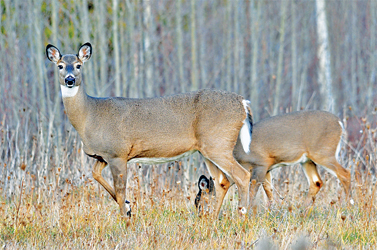PETERBOROUGH—Although it is concerning that confirmed findings of Epizootic Hemorrhagic Disease (EHD) were found recently in two white-tailed deer in south-western Ontario, it is not a crisis situation, says a representative of the Ontario Federation of Anglers and Hunters (OFAH).
“It is a concern, but not a crisis. Actually EHD is common in the U.S. with outbreaks reported every year which results in some dead deer in certain places,” said Mark Ryckman, of the OFAH on Monday of this week. “It depends on the weather conditions and deer bitten by midges.”
Mr. Ryckman acknowledged that the recent confirmation of two deer in southwestern Ontario with EHD “is the first time that we have heard EHD confirmed in Ontario.”
Ontario hunters and anyone closer to nature are being asked to be on the lookout for deer exhibiting symptoms of EHD, or Epizootic Hemorrhagic Disease, an infection wildlife officials are trying to track.
The Ministry of Natural Resources and Forestry (MNRF) issued an advisory September 27 after the discovery of two dead male deer on a property in London, Ontario on September 12. These are the first confirmed cases in Ontario of EHD, an infection often fatal in white-tailed deer, according to ministry spokesperson Jolanta Kowalski.
EHD is not a public health threat, and eating meat from deer that are free from signs of sickness such as ulcers, abscess, or other abnormalities is considered safe.
“Hunters should, as always, practice proper carcass handling and processing techniques when they’re dressing hunted deer,” said Ms. Kowalski in the advisory. She said people should not eat something they are not 100 percent sure of.
The condition has several telltale signs, Ms. Kowalski said. “An infected deer would lose their appetite. They wouldn’t be fearful of people. They get weak. They salivate excessively. They get a really fast pulse and breathing rate. And they show signs of fever.” That means they will submerse themselves in bodies of water to try to reduce their body temperature and that’s why they can often be found dead in or near water. They may also have a blue tongue and their head, neck, and tongue could be swollen as well.
While the disease is common throughout the United States, the province does not want to see it spread, said Ms. Kowalski. The disease is spread, not from deer to deer, but through bites from midges so its spread is dependent on the insect population.
Midges die off during the first frosts, taking the virus with them says the MNRF.
“We knew it was only a matter of time when there would be a confirmed case of EHD-because there have been reports of suspected cases in the past, and it is right next door at our neighbour’s (U.S.),” said Mr. Ryckman. “It has not, and hopefully will never be found in areas like Manitoulin Island, unless the climate continues to change. But it will probably never hit your (Manitoulin) area, and will probably not jeopardize the deer populations in Ontario.”
The MNRF advisory notes that if you suspect a deer you’ve seen or killed could be infected with EHD, the ministry suggests you call the Canadian Wildlife Health Cooperative-which is tracking cases-at 1-866-673-4781 or by calling the Natural Resources Information Centre at 1-800-667-1940.





